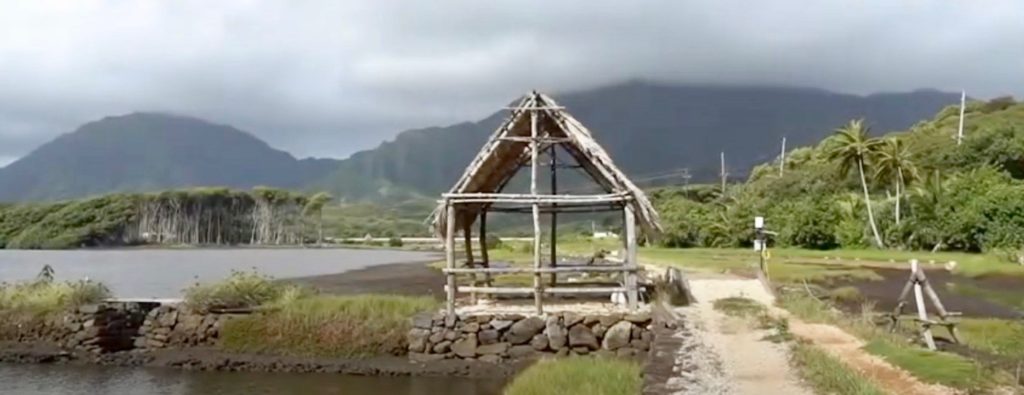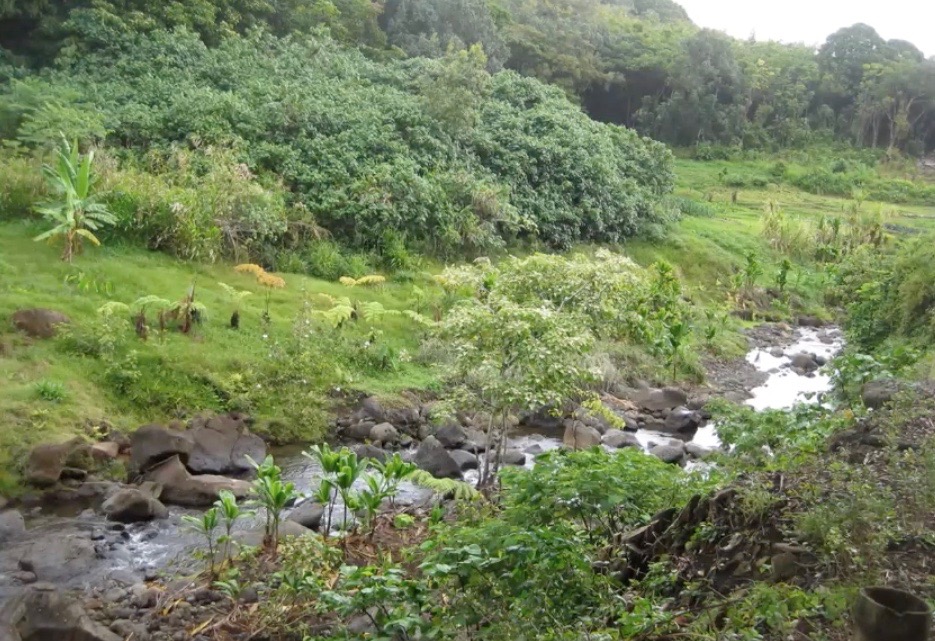The state Commission on Water Resource Management last month ordered the Honolulu Board of Water Supply to complete a feasibility study and preliminary engineering design within two years for a new bulkhead in its Ha‘iku Tunnel in Windward O‘ahu.
As an interim measure, the commission also ordered the BWS to cut the amount of impounded dike water it takes from the tunnel down to 0.3 million gallons a day by August 15.
“We want a yes or no in two years [on the bulkhead]. If it’s a no, then we need to take appropriate action to protect instream standards,” said Water Commission hydrologist Ayron Strauch.
Commission staff has already proposed setting the interim instream flow standard for He‘eia Stream at 1.77 mgd. Currently, during the summer months, the stream only has 0.3 mgd per day flowing in it, according to Strauch.
If the bulkhead is deemed feasible, the commission voted to require the BWS to complete construction within three years.
Priority Uses
The commission’s goal with these orders is to increase flow in He‘eia Stream. Over the past two decades, non-profit groups have restored acres of lo‘i kalo (taro patches) and an ancient Hawaiian loko i‘a (fishpond) that rely on the stream’s flow.

“That’s a lot of time, energy and resources, and funding that have been put towards the restoration of an ahupua‘a. What we want to see is 100 percent return of water … to He‘eia,” Paepae o He‘eia executive director Hi‘ilei Kawelo told the commission last month via video recorded testimony.
While standing in the pond itself, she showed how, in the past, they used to let a trickle of water from the stream enter the fishpond through a gate, leaving the rest to flow into the ocean. In recent months, however, stream flow has dropped so low that they’ve boarded up the gate, regardless of how badly the pond’s fish need the freshwater.
Because the ecosystem needs that water to flow into the ocean, as well, it would be irresponsible for Paepae o He‘eia to lift the boards that are keeping the water in the stream, she said.
As a result, “the health of the loko i‘a is hampered by the lack of freshwater. … Freshwater is the engine that drives productivity,” added Keli‘i Kotubetey, assistant executive director of Paepae o He‘eia.
They and other staff from the groups working in He‘eia have testified that the fishpond is too salty and stagnant, and that despite clearing acres of thick mangrove to allow stream water to enter the ‘auwai, flow from the stream still doesn’t reach all the lo‘i that have been restored so far. It was “incredibly heartbreaking,” testified Nicholas Reppun, a farmer with the group Kako‘o ‘Oiwi, which is restoring and expanding the lo‘i just Mauka of the fishpond.
Under the Hawai‘i constitution, maintaining waters in their natural state and the use of water in the exercise of native Hawaiian and traditional and customary rights are protected, public trust uses that would seem to take priority over watering golf course greens.
As Strauch has repeatedly pointed out, some of largest users of freshwater in the island’s Ko‘olau Poko district are golf courses. The largest user by far is the Kane‘ohe Marine Corps Base, which also has a golf course.
Many of those large users, including the base, receive water from the BWS’s 272-foot elevation system, and not from the 500-foot system that draws water from sources that would otherwise feed He‘eia Stream. Even so, Strauch pointed out that as of March, the BWS was dropping 0.89 mgd from its 500-foot system into its 272-foot system, which receives water from a variety of sources.
Strauch suggested that if the Marine base went back to using recycled water on its golf course, that would lessen the need to transfer so much water from the 500-foot system, and, therefore, lessen the need to take water from sources that feed He‘eia Stream.
“Trying to rectify how we manage sources with permits and end uses that may not be consistent with protecting public trust needs is challenging and we don’t have all the tools that we might want, but this is a really good first step,” he said.
Finding Solutions
BWS manager Ernie Lau supported the notion of getting the Kane‘ohe Marine Base to return to watering its golf course with recycled water. And BWS program administrator Barry Usagawa said he had recently spoken to base personnel about it and reported that it likely wouldn’t happen until sometime after the end of the year.
He pointed out that the state Department of Health restricts the use of R2 water — which is what the base’s wastewater treatment plant produces — and requires a 500-foot buffer between where it is used for irrigation and the nearest homes.
Because the base wants to spray its green spaces with the recycled water, it’s planning to plant a tree buffer around the homes. Usagawa said that the base planned to award tree-planting contract toward the end of this year.
He argued that it would be simpler to find a solution within the 500-foot system, rather than try to force conservation measures outside of it.
He noted that in the 500-foot system, the largest water user is the state hospital in Kane‘ohe, which being renovated but is planning to reopen in two months at a larger capacity.
It is using 23,000 gallons a day during construction. At full buildout, he said, it will use 200,000 gallons per day.
Anticipating that the Water Commission would require it to reduce its withdrawal of water from the Ha‘iku Tunnel, the BWS has recently reduced its take from about 1 mgd to 0.5 mgd. The reopening of the hospital will all but erase that progress at the same time the commission is asking the BWS to bring its tunnel withdrawals down to 0.3 mgd — “a double whammy,” he said.
He added that the commission was asking the BWS to cut back 85 percent of its permitted use for the area. “We question how fair that is, how workable that is,” he said.
As an alternative, he suggested that the state install a pump in an old well on the hospital property and take the hospital off the BWS’s system.
That well can provide as much as 720,000 gallons of water a day and would not affect He‘eia Stream, he said, adding that the well could serve both the hospital and the adjacent Windward Community College, which uses only 13,000 gallons a day.
“Those are both state properties. Both use Ha‘iku Tunnel water. … We believe the government should lead by example and require the state to put a pump in that existing well. That would help us accommodate the reduction to 0.3 mgd,” he said.
He and Lau admitted that the idea to install a pump in the well was brand new and had not been run by the state Department of Land and Natural Resources or Department of Health, which would need to agree to it.
They also noted that some BWS system operators are concerned that throttling down withdrawal from the tunnel to 0.3 mgd will create pressure changes that may lead to main breaks, especially in Maunawili.
With regard to the commission’s order to install a deeper bulkhead in the Ha‘iku Tunnel, which according to the U.S. Geological Survey would restore the storage capacity of the high elevation aquifer, Lau said the BWS agrees that increasing dike storage will benefit the watershed, but explained that installing a bulkhead won’t be easy or quick. Just getting workers into the narrow spaces in the tunnel may be difficult and, once construction is done, the board would have to work with the Health Department to ensure that the water is safe to drink before bringing that source back online, he said.
He added that as part of a study of the He‘eia watershed, the USGS will begin seepage runs this summer to determine what sections of He‘eia stream are gaining and losing.
Fred Reppun, education coordinator for the He‘eia National Estuarine Research Reserve (HNERR), had testified earlier in the meeting that he supported the commission going ahead and adopting a new interim instream flow standard of 1.77 mgd for He‘eia, rather than relying on bulkheading the tunnel.
“Whether it will increase flow in He‘eia Stream is an open question,” he said, noting that summer water levels had dropped despite the BWS’s reduction in withdrawals from tunnel.
“Regulation of Ha‘iku Tunnel alone does not protect the stream,” he argued.
HNERR director Kawika Winter added his concern that forcing a reduction in withdrawals from the tunnel might simply lead the BWS to increase the amount it takes from its wells in the area, which might then affect springs.
Strauch noted later in the meeting that understanding whether withdrawals from the BWS’s Ha‘iku or Ioleka‘a wells will affect stream flow is being studied by USGS. He suggested caution should be taken with withdrawal from wells, adding that the goal of the commission’s proposals “was not to take one source off so they can take advantage of another source. The goal was to restore stream flow and restore the functionality of the aquifer [and] capacity of the mountain to sustain streams and springs that would feed not only He‘eia, but also neighboring ahupua‘a.”
Lau, who had recently toured the fishpond and taro fields with the non- profit groups, said that in addition to what the commission was requiring, the BWS wanted to partner with Kako‘o ‘Oiwi to see how the two organizations can work together to increase conveyance efficiencies.
Water Commissioner Neil Hannahs said he understood the BWS needed time — to better understand the watershed, determine whether it was feasible to bulkhead the tunnel, and then construct it. But he urged the BWS to move with alacrity.
He noted that both the Water Commission and the BWS are currently aligned in their holistic approaches to water management. But, he added, “our sense of alignment and philosophy, sometimes these things come and go. …We are aligned right now. We need to get as much done as we can do right now because of our alignment. … Climate change and other urgencies also compel us.”
In the end, commission staff committed to reporting back in September on BWS’s tunnel withdrawal reduction and its impact on flow, if any; on the agency’s progress toward assessing bulkhead feasibility and the engineering report; and on the potential development of alternative water sources, including the state hospital well.
(For more background on this, see our March 2021 cover story, “Commission Pressures BWS To Meet Proposed He‘eia Stream Flow Standards.”)
— Teresa Dawson



Leave a Reply